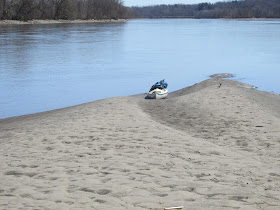On day two of my visit to the Mohawk River Valley I found that despite the recent heavy rains the Mohawk River water level was quite low with a fast current. I'd later learn that in addition to closing down lock operations and removing navigational buoys for the winter, the NYS Canal System also lowers the water level by lifting the movable dams between Schenectady and Fort Plain. This allows the river to return to a more natural state and prevents ice and debris from accumulating.
Paddled upriver while hugging the river's east shoreline where the current wasn't as strong. Kept an eye out for any sign of what was once called the "Painted Rocks". I'd read about these pictographs in The Navigators, A Journal of Passage on the Inland Waterways of New York by Philip Lord Jr. Lord includes this 1793 description of the pictographs by Jacob Lindley "This day we passed a rock projecting out of the bank of the river, whereon was painted, with great ingenuity, in red colours, a canoe with the representation of seven men in it, which is said to be done annually by Indians, coming several hundred miles for that purpose, in order to commemorate the slaughter of seven Indians, who went off from that neighborhood in some former wars, and were all destroyed." The description had me wondering if the pictographs might possibly have been related to the 1669 battle between the Mohawks and the Algonquins which occurred about 7 miles further downriver at Kinquariones. The Mohawks are said to have passed this spot while canoeing to the battle. Passed this smooth faced boulder with some reddish tinted areas...
...and a little further upriver this ledge...The ledge was near the freight house mentioned by one witness. This view shows the ledge and the freight house to its left...Post paddle I drove approximately 11 miles west on Route 5 to the Mohawk village Caughnawanda near Fonda...
The palisaded village and its 12 longhouses are staked out...
To the rear of the above photo the terrain slopes steeply (about 40') down to Cayadutta Creek. The site is approximately half a mile from the Mohawk River. Walking around the village I was struck by the similarities to the village of Nanrantsouak alongside the Kennebec River in Madison, Maine. Both villages were palisaded, on high ground, and accommodated a Jesuit chapel.
Caughnawaga was the Mohawk village attacked by Wompatuck and his Algonquin warriors in August 1669. When Wompatuck's attack failed he and his warriors retreated about 18 miles east to Wolf Hollow...
...to where the Mohawks ultimately found and defeated them. The battle site is named Kinquariones for an earlier Algonquin village located nearby...
A look down the hollow...
The Massachusetts sachem Wompatuck never left this area as he fell in battle. For his warriors that survived the journey home must have been miserable. The Massachusetts Bay Colony Superintendent of Christian Indians, Daniel Gookin, said at the time "This was a severe stroke to these Indians, and they suffered much from chagrin on the way home." Meanwhile the Mohawks and their leader Kryn celebrated a great victory.
Day three to follow.


















No comments:
Post a Comment
Comments welcome